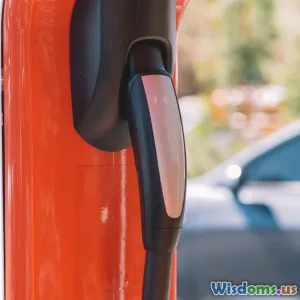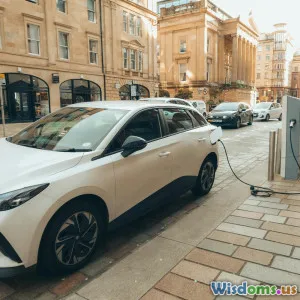
Innovations in Car Battery Technology
8 min read Explore cutting-edge breakthroughs powering the future of car batteries—faster charging, longer life, and greener tech. (0 Reviews)
Innovations in Car Battery Technology
Electric vehicles (EVs) have rewritten the rulebook for transportation, promising cleaner air, reduced greenhouse emissions, and enhanced driving experiences. At the heart of this revolution lies one critical component: the car battery. For decades, battery technology was a limiting factor—heavy, slow to charge, and costly. Today, rapid technological innovations are addressing these challenges and reshaping the automotive landscape. This article dives deep into the latest advances in car batteries, exploring how emerging technologies are paving the way for faster charging times, extended driving ranges, enhanced safety, and sustainability.
The Evolution of Car Batteries: From Lead-Acid to Lithium-Ion
The journey of car batteries mirrors the shift from internal combustion engines to electric propulsion. Traditional vehicles relied on lead-acid batteries exclusively for starting engines and powering auxiliary systems. These batteries, while inexpensive and reliable, lacked high energy density, thus unsuitable for powering vehicles alone.
The advent of lithium-ion batteries offered a game-changing alternative. With significantly higher energy density—around 150-250 Wh/kg compared to lead-acid’s ~30-50 Wh/kg—lithium-ion became the standard for EVs. Tesla, Nissan, and Chevrolet leveraged this technology to launch popular EV models that proved electric cars could be practical and desirable.
Yet, lithium-ion has its drawbacks, including degradation over multiple charge cycles, flammable electrolytes raising safety concerns, and supply chain issues tied to cobalt and lithium mining.
Breakthroughs in Battery Chemistry
1. Solid-State Batteries: The Next Big Leap
Solid-state batteries replace the liquid electrolytes in lithium-ion batteries with solid electrolytes, such as ceramics or sulfide-based materials. This change offers multiple benefits:
- Higher Energy Density: Solid electrolytes enable the use of lithium metal anodes, potentially doubling energy density to >400 Wh/kg.
- Safety: Solid electrolytes are non-flammable, virtually eliminating the risk of battery fires.
- Longevity: Solid-state batteries show less capacity fade through thousands of cycles.
Prominent companies, including Toyota and QuantumScape, have reported progress in developing commercially viable solid-state batteries. Toyota aims to debut solid-state battery-powered EVs by the mid-2020s, promising over 500 km (310 miles) of range with 10-minute charging times.
2. Silicon Anodes to Replace Graphite
Lithium-ion batteries traditionally use graphite anodes, which limit capacity. Silicon anodes can store nearly 10 times more lithium, dramatically increasing energy density.
However, silicon expands significantly during charge cycles, causing mechanical instability. Innovations such as silicon nanowires and composite anodes are overcoming these obstacles. For example, Tesla is reportedly incorporating silicon-dominant anode designs into their upcoming '4680' cells, improving range and battery life.
3. Lithium-Sulfur and Lithium-Air Batteries
Research into lithium-sulfur and lithium-air batteries promises ultra-high theoretical energy densities, exceeding 500 Wh/kg. These chemistries utilize abundant, inexpensive materials like sulfur or even oxygen from air.
While challenges like poor cycle life and efficiency remain, companies like Oxis Energy have demonstrated lithium-sulfur cells achieving over 1,000 charge cycles with promising results for aviation and automotive applications.
Advancements in Battery Management and Charging Technologies
Intelligent Battery Management Systems (BMS)
Optimizing battery performance extends beyond chemistry. Today's BMS integrates advanced algorithms, machine learning, and real-time monitoring to improve charging efficiency, predict battery health, and prevent failures.
For instance, BMS can modulate charging rates to avoid overheating and degradation, enabling fast charging while preserving longevity. Manufacturers increasingly embed over-the-air update capabilities, allowing continuous improvement post-sale.
Ultra-Fast and Wireless Charging
Charging speed remains a top consumer concern. Innovations like Tesla’s Supercharger V3 enable charging rates up to 250 kW, replenishing 75 miles of range in 5 minutes. Similarly, Ionity offers 350 kW fast chargers, compatible with newer EVs.
Wireless charging technology is also progressing, utilizing inductive pads installed in homes or public spaces. BMW and Audi have tested wireless charging for ease and hands-free operation, especially useful for autonomous vehicles.
Sustainability: Recycling and Second-Life Applications
The environmental impact of battery production and disposal is a critical focus. Recycling technologies are advancing to recover key materials like lithium, cobalt, and nickel efficiently. Tesla, for example, incorporates closed-loop recycling programs aiming to source 100% of battery materials sustainably.
Moreover, used EV batteries retain significant capacity after their automotive life. Repurposing them for stationary energy storage—as seen with projects like Nissan’s ‘Second Life’ batteries integrated into renewable grids—reduces waste and supports grid stability.
Real-World Impact and The Road Ahead
The influence of battery innovations is evident globally:
- Extended Range and Affordability: New batteries enable EVs with 500+ km range at competitive prices, alleviating range anxiety and accelerating adoption.
- Regulatory Support: Governments worldwide are incentivizing EV adoption, backed by advancements making EVs practical and desirable.
- Commercial and Public Transport: Enhanced batteries facilitate electric buses and delivery trucks, lowering emissions in urban centers.
Industry experts like Dr. Jeff Dahn, Chief Scientist at Tesla, assert, “Battery development is the most critical enabler of electrified transport. The next decade will see energy densities and costs improve faster than many analysts predict.”
Conclusion
Innovations in car battery technology are the linchpin for sustainable, efficient transportation. From the shift to solid-state batteries to intelligent management and refined chemistries, the future of EV batteries promises safer, longer-lasting, and more sustainable power sources. As researchers and manufacturers continue to push boundaries, drivers can anticipate electric vehicles that not only match but surpass traditional cars in convenience, performance, and environmental impact. Staying informed about these breakthroughs empowers consumers, investors, and policymakers to support technologies driving the green revolution on wheels.
Engage with this dynamic field today—whether by choosing an EV, advocating for cleaner transport policies, or exploring careers in energy technology—to help accelerate a cleaner, electrified future.
Rate the Post
User Reviews
Popular Posts


















